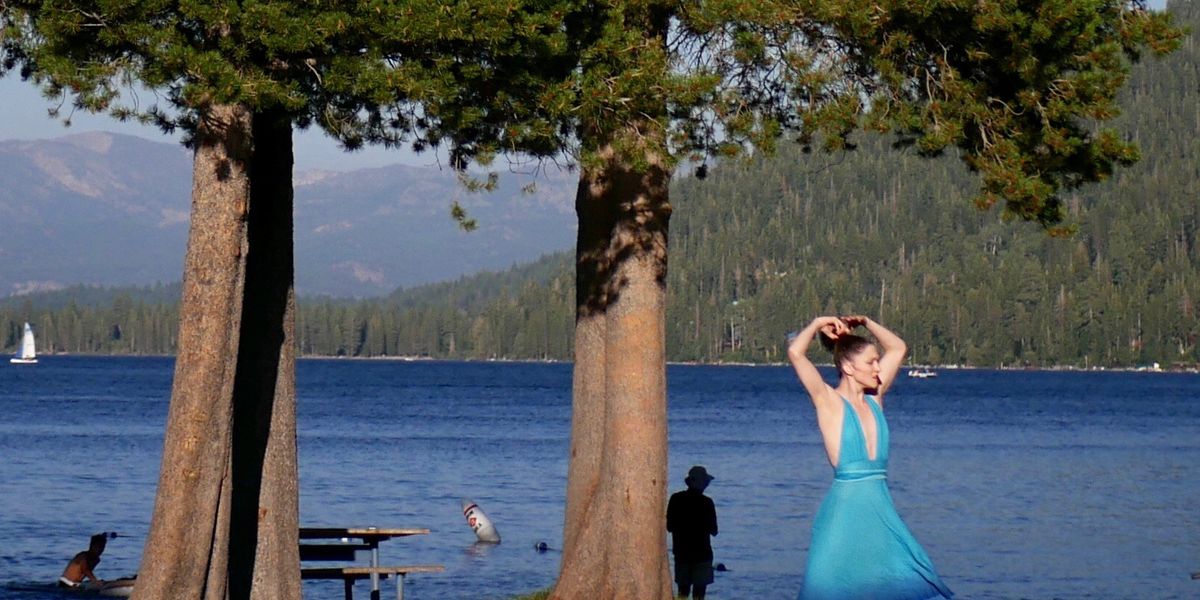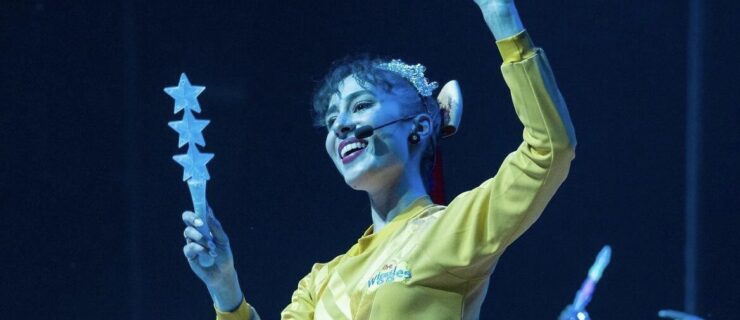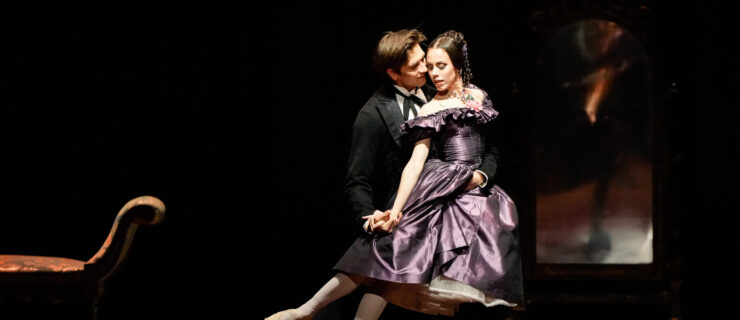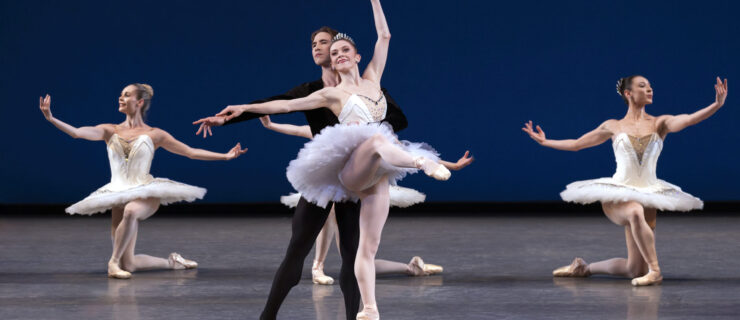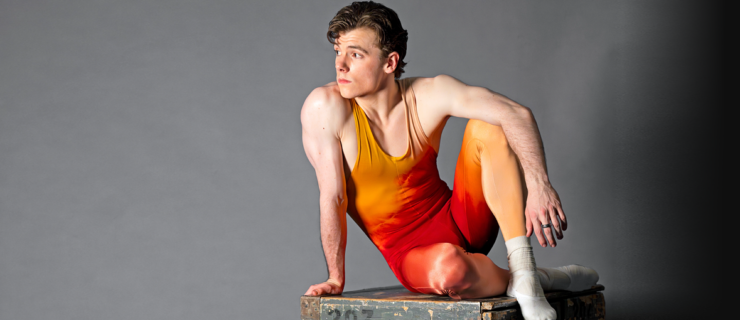"We Can Only Grow from Diversification": A Conversation with Ashley Bouder and Lauren Lovette
Last week, Ashley Bouder joined an all-star cast of performers at the 5th annual Lake Tahoe Dance Festival. Co-directors Christin Hanna and Constantine Baecher curated a dramatic evening that included a world premiere by Marco Pelle, iconic masterworks by Lester Horton and Paul Taylor, contemporary favorites by Baecher and Robert Moses, and the California premiere of Red Spotted Purple—a solo for Bouder choreographed by her New York City Ballet colleague, Lauren Lovette.
Named after a butterfly, Red Spotted Purple was made for The Ashley Bouder Project’s most recent season at the Joyce Theater’s Ballet Festival. Lovette’s playful and free-spirited solo seemed ripe for an outdoor performance, especially against Tahoe City’s gorgeous landscape of pine trees and its blue lake. Featuring both a commissioned score by Stephanie Ann Boyd and a gorgeous dress designed by Michelle Smith of MILLY, the solo dance was in line with Bouder’s mission to promote more diversity in ballet’s creative process. I caught the performance in Tahoe City and chatted with the two women via email about the experience of making this dance.
How did this commission come about?
Ashley Bouder:
I was brainstorming female choreographers that I’d want to create a solo for me. I thought, who better than a colleague that grew up watching me dance? There isn’t a female choreographer out there that knows my dancing better, or my personality on and off stage. I think Lauren is brilliant, and after having seen her two pieces for NYCB, I felt that she could make something special with a clear point of view and message. I wanted the solo to open the [Joyce] program and I just knew she could make a statement piece to fit.
When in the process was music chosen? Ashley, I have read somewhere about your interest in female composers…
AB:
I had already decided that I’d like to commission Stephanie Ann Boyd at some point. I had choreographed a small duet to her music last year, and had since listened to many of her pieces. When I commissioned Lauren, my music director Ron Wasserman and I gave her a list of female composers to see if she thought [her choreographic style] fit any of them. She actually chose the piece of music by Stephanie that I had used before, so it felt right to commission her for this solo.
Lauren Lovette:
Ashley has been such an advocate for female composers and when she told me about Stephanie Ann Boyd, I immediately looked into her music. I originally wanted to use one of her existing works, but we agreed that it would be easier to create a new composition than to rearrange one of her existing works for jazz band.
AB:
I also only gave Lauren a list of female composers because I realized that I had never danced to a woman’s music before starting my company. It seems crazy to me that that is true. I feel strongly that I must help change this.
 Bouder performs “Red Spotted Purple at the Lake Tahoe Dance Festival. Photo by Bret Shuford, Courtesy Lake Tahoe Dance Festival.
Bouder performs “Red Spotted Purple at the Lake Tahoe Dance Festival. Photo by Bret Shuford, Courtesy Lake Tahoe Dance Festival.
Both of you have been positive female role models, inspiring and empowering many young dancers. Was the experience of making this dance work, with the two of you in the studio, particularly powerful or different?
LL:
Ashley’s solo was the first time I have worked with only one human on a piece of choreography. I found it artistically challenging, but deeply rewarding to work in such a personal and intimate way. I made almost all of the material in the studio on Ashley herself, and if I did prepare anything I pulled from either what I have seen Ashley do in class or onstage at NYCB. Ashley is such a quick study that we were able to create something true to both of our styles easily.
AB:
The experience of working with women choreographers is totally different than working with men. There is an understanding and ease for me with women. I get the whole male patriarchy thing, men hiring men, etc. It feels more comfortable to work within your own gender, most of the time. But having said that, it is important to work with people outside your gender and race. We can only grow from diversification. Only when everyone is equal can we truly feel comfortable and become our most creative.
I do think the experience of working with Lauren was powerful. The jokes, the laughter, the seriousness—all were integral to this creation. I think we both know very profoundly how much what we are doing means to the next generation of women. I think often and deeply about how I want the world to look for my young daughter, and those thoughts go into what I do everyday.
How do you keep edifying yourselves—who do you look to for hope and inspiration?
AB:
I look at my peers making their marks. I look to the strong women dance leaders of the past: Martha, Pina, Isadora. Ballet needs names like that. I let strong women political figures inspire me: Hillary Clinton, Kamala Harris, Ruth Bader Ginsburg. And I read, read, read.
What do you admire in each other?
LL:
I admire Ashley’s hands-on approach to life and her deep honesty in her convictions. What you see is what you get, and she will always fight for what she believes in. I have been looking up to Ashley since I first saw the NYCB dance, and ever since I have respected her work ethic, technique and, most of all, belief in the the female voice.
AB:
I first noticed Lauren dancing in the corps of Concerto Barocco in SAB’s workshop performances about 10 years ago. I thought, Who is that? She’s a star. And look at her now, accomplished principal dancer and dazzling choreographer. I admire Lauren’s grace, her ability to pick herself up and dust herself off, and her spark. I trust in her future. She has it, that something that makes you sit up and pay attention. Whether she’s onstage or has created what we see onstage, she demands our attention.
